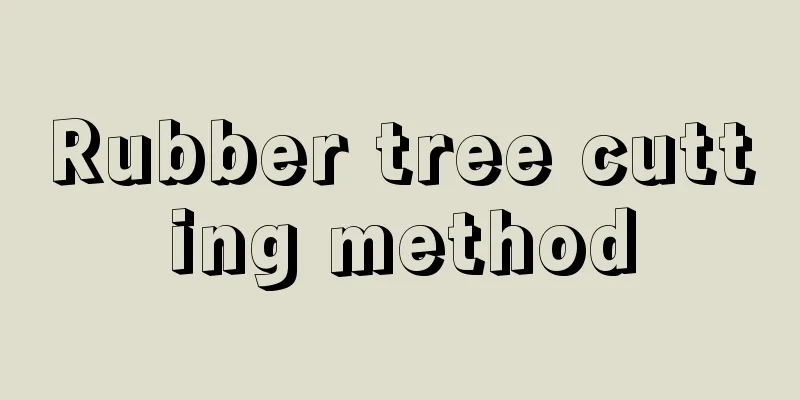When and how to change the soil of ivy

Ivy soil replacement timeThe best time to change the soil for ivy is in spring, March or April, because the climate and temperature are suitable during this period, and the plant gradually resumes growth. Repotting can reduce damage to it, and it can recover faster, which can increase the possibility of survival. How to repot and change soil for ivy1. Remove from the pot and trim the roots: When repotting ivy, you must first remove the pot. Be careful not to damage the roots, especially the new roots, which will prolong the acclimatization time. After removing from the pot, loosen the soil and trim the roots. Old roots, dead roots and rotten roots must be cut off to reduce water and nutrient consumption and promote more vigorous growth in the later stage. 2. Prepare new soil: When repotting ivy, you should not only replace it with a new large pot, but also change the soil. It is best to pour out all the original soil and replace it with fertile, well-drained and loose nutrient soil. This will help the plant germinate and recover better. It is usually mixed with river sand, garden soil and leaf mold. Pay attention to disinfection before use. 3. Planting in pots: Wait until the wounds of the ivy are dry before planting. Just dig a hole and put it in the soil. Cover the soil and compact the surrounding soil. Water it thoroughly to promote faster recovery. In addition, management should be strengthened in the later stage. It is recommended to place it in a cool and well-ventilated place. Don't rush to expose it to the sun. It will recover in about a week. Notes on changing soil for ivy1. Repotting time: Pay attention to the time selection when repotting ivy. Although it can be done in all seasons, it is best to choose spring when the climate is relatively more suitable. It can increase the possibility of survival, reduce damage to it, and its later growth will be more vigorous. 2. How to remove the ivy from the pot: When repotting ivy, you should also pay attention to the method of removing the ivy from the pot. Try not to damage the new roots, otherwise the adaptation period will be prolonged. In addition, you should trim the root system after removing the ivy from the pot, cut off some old roots, dead roots, rotten roots, and residual roots, and clean and disinfect them after pruning so that they can better absorb water and nutrients in the later stage. 3. Prepare new soil: When caring for ivy, you usually need to repot it once a year, and be sure to mix new soil. The soil must be loose, breathable, and fertile. It can be mixed with river sand, garden soil, and leaf mold, but all the old soil must be replaced, otherwise it will easily become hardened and hinder growth. In addition, the newly prepared soil must be disinfected before use. 4. Base fertilizer : When changing the soil of ivy, you can apply some base fertilizer. Bone meal can be used as base fertilizer. The fertilizer must be fully decomposed and diluted with water before use. 5. Later maintenance: The ivy that has just been repotted is relatively weak and needs to be managed more strictly. Be careful not to expose it to the sun too quickly. Place it in a cool and ventilated place first, and then manage it normally after it resumes growth. Maintenance method of ivy after soil changeAfter changing the soil, ivy needs to be maintained in a semi-shaded environment. The root system is very fragile at this time. If it is exposed to strong light, the whole plant will die. In addition, do not water it too much, the soil in the pot should not be too moist, and stop fertilizing. Watering after soil replacementAfter changing the soil of ivy, you can water it thoroughly to promote the close combination of roots and soil. You need to wait until the soil is completely dry before watering again. Leaves turn yellow after changing soilIf the ivy has yellow leaves shortly after being repotted, there is no need to worry too much. It may be that it has not adapted yet. With strengthened management, it will recover soon. However, if it still has yellow leaves a long time after being repotted, it may not have adapted to the pot. It is best to remove the pot, check, and re-care for it. See the sun after changing the soilAfter changing the soil, ivy needs to be kept in a semi-shaded place, away from the sun. It can only be slowly maintained after the roots grow out. At this time, it can be exposed to some soft light. |
<<: How to propagate lipstick spider plant and what to pay attention to
>>: How to propagate Zephyranthes and what to pay attention to
Recommend
Can perilla be hydroponically cultivated? Hydroponics methods and precautions
Can perilla be grown hydroponically? Perilla can ...
Garden application of fortune tree
Garden uses of fortune tree Fortune Tree as a Gar...
If he grows his asparagus fern like this, it will remain green even in summer and the leaves will not turn yellow even after 10 years!
Basic Introduction Asparagus fern is naturally li...
How often should I water the Osmanthus fragrans
1. Spring We all know that this is a flower that ...
How to care for purple pearls in summer
Summer maintenance Purple pearls are not resistan...
What compound fertilizer is better for growing vegetables? How to fertilize vegetables with quick-acting compound fertilizer?
Good fertilization is the key to good vegetable c...
When is the best time to plant carnation seeds?
Carnation seeds planting time Carnation is a pere...
Cultivation methods and precautions of Anku Rhododendron
Anku azalea is a very hardy and easy-to-grow flow...
Is it better to grow precious bamboo in water or soil?
Is it better to grow precious bamboo in water or ...
What is the matter with rose blind branches?
Blind branches appear in roses Blind branches ref...
Lotus potting skills, what should you pay attention to
1. Potted Planting 1. Seeds: If you want to plant...
Where is the best place to plant the red spider lily and what is the best environment for it to grow?
Place where red spider lilies are planted Red spi...
What soil is suitable for growing ginger?
Ginger is a tuberous plant, and its soil requirem...
When is the best time to apply fertilizer to hazelnut trees?
Topdressing time for hazelnut trees The first fer...
How to breed Luanfeng Jade
Seed propagation of Luanfengyu Seeding propagatio...









